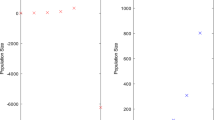Abstract
We present a simple model for describing the dynamics of the interaction between a homogeneous population or society, and the natural resources and reserves that the society needs for its survival. The model is formulated in terms of ordinary differential equations, which are subsequently discretised, the discrete system providing a natural integrator for the continuous one. An ultradiscrete, generalised cellular automaton-like, model is also derived. The dynamics of our simple, three-component, model are particularly rich exhibiting either a route to a steady state or an oscillating, limit cycle-type regime or to a collapse. While these dynamical behaviours depend strongly on the choice of the details of the model, the important conclusion is that a collapse or near collapse, leading to the disappearance of the population or to a complete transfiguration of its societal model, is indeed possible.
Similar content being viewed by others
References
Forrester, J. W., World Dynamics, Cambridge, Mass.: Wright-Allen Press, 1971.
Meadows, D. H., Meadows, D. L., Randers, J., Behrens, W. W. III, The Limits to Growth: A Report for the Club of Rome’s Project on the Predicament of Mankind, New York: Universe Books, 1972.
Malthus, Th., An Essay on the Principle of Population, London: Johnson, 1798.
Hardin, G., The Tragedy of the Commons, Science, 1968, vol. 162, no. 3859, pp. 1243–1248.
Turner, G., A Comparison of “The Limits to Growth” with 30 Years of Reality, Global Environ. Chang., 2008, vol. 18, no. 3, pp. 397–411.
Brander, J. and Taylor, M. S., The Simple Economics of Easter Island: A Ricardo - Malthus Model of Renewable Resource Use, Am. Econ. Rev., 1998, vol. 88, no. 1, pp. 119–138.
Motesharrei, S., Rivas, J., and Kalnay, E., Human and Nature Dynamics (HANDY): Modeling Inequality and Use of Resources in the Collapse or Sustainability of Societies, Ecol. Econ., 2014, vol. 101, pp. 90–102.
Grammaticos, B., Ramani, A., Satsuma, J., and Willox, R., Discretising the Painlevé Equations à la Hirota - Mickens, J. Math. Phys., 2012, vol. 53, no. 2, 023506, 24 pp.
Tokihiro, T., Takahashi, D., Matsukidaira, J., and Satsuma, J., From Soliton Equations to Integrable Cellular Automata through a Limiting Procedure, Phys. Rev. Lett., 1996, vol. 76, no. 18, pp. 3247–3250.
Willox, R., Grammaticos, B., Carstea, A. S., and Ramani, A., Epidemic Dynamics: Discrete-Time and Cellular Automaton Models, Phys. A, 2003, vol. 328, no. 1, pp. 13–22.
Bountis, T.C., Ramani, A., Grammaticos, B., and Dorizzi, B., On the Complete and Partial Integrability of Non-Hamiltonian Systems, Phys. A, 1984, vol. 128, no. 1, pp. 268–288.
Sprott, J. C., Some Simple Chaotic Flows, Phys. Rev. E, 1994, vol. 50, no. 2, R647–R650.
Holling, C. S., Some Characteristics of Simple Types of Predation and Parasitism, Can. Entomol., 1959, vol. 91, no. 7, pp. 385–398.
Bardi, U., The Seneca Effect: Why Growth Is Slow but Collapse Is Rapid, Cham: Springer, 2017.
Hubbert, M. K., Energy Resources, Washington, D.C.: National Academy of Sciences, 1962.
Willox, R., Ramani, A., Satsuma, J., and Grammaticos, B., From Limit Cycles to Periodic Orbits through Ultradiscretisation, Phys. A, 2007, vol. 385, no. 2, pp. 473–486.
Mickens, R. E., Exact Solutions to a Finite-Difference Model of a Nonlinear Reaction-Advection Equation: Implications for Numerical Analysis, Numer. Methods Partial Differential Equations, 1989, vol. 5, no. 4, pp. 313–325.
Acknowledgements
The authors would like to acknowledge most stimulating discussions with A. Ramani. R. Willox would like to acknowledge support from the Japan Society for the Promotion of Science (JSPS), through the JSPS grant: KAKENHI grant number 18K03355.
Author information
Authors and Affiliations
Corresponding authors
Ethics declarations
The authors declare that they have no conflicts of interest.
Rights and permissions
About this article
Cite this article
Grammaticos, B., Willox, R. & Satsuma, J. Revisiting the Human and Nature Dynamics Model. Regul. Chaot. Dyn. 25, 178–198 (2020). https://doi.org/10.1134/S1560354720020045
Received:
Revised:
Accepted:
Published:
Issue Date:
DOI: https://doi.org/10.1134/S1560354720020045
Keywords
- population dynamics
- dynamical systems
- collapse
- resources and reserves
- discretisation
- generalised cellular automaton




